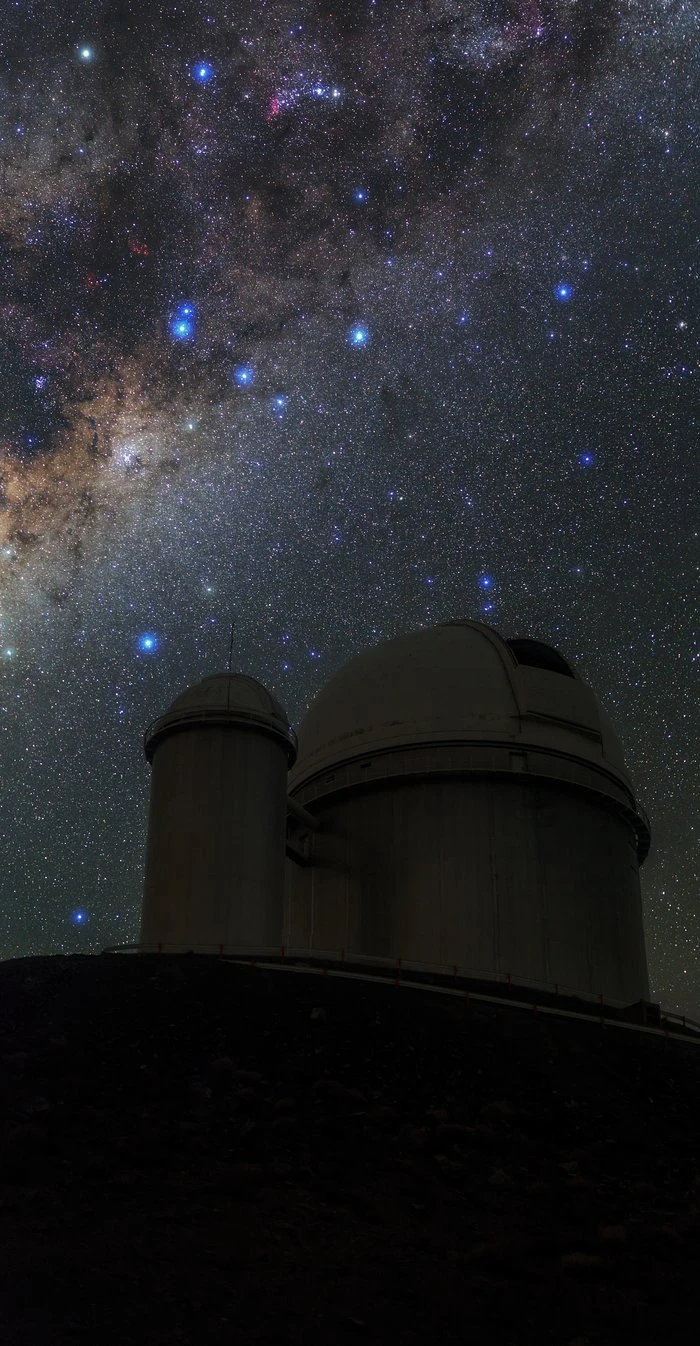Frequently Asked Questions
The La Silla Observatory is located on the borders of the Chilean Atacama Desert, located 600 kilometers north of Santiago de Chile, in the southern part of the Atacama Desert and at an altitude of 2,400 meters. It is accessed through an entrance on Route 5 North about 160 kilometers north of La Serena and 80 kilometers southeast of La Higuera.
The Paranal observatory is located approximately 130 kilometers south of Antofagasta. From Taltal, it is located around 200 kilometers north.
Visits last two and a half hours.
1. The tour begins at the Visitor Centre where you will enjoy a walk through an exhibition about the Observatory and astronomy in general. This include an exhibition about the evolution of astronomical detectors and the recreation of an old control room.
2. Then you will visit the ESO 3.6-metre telescope, and if conditions allow, the New Technology Telescope (NTT).
3. Everything will finish with spectacular views of the desert and the Andes.
The order of the steps described above may vary depending on the number of people in the tour.
1. The tour begins at the Visitor Centre where you will enjoy an exhibition about the Observatory and astronomy.
2. Then you will be taken to the VLT platform and enter the dome of one of the 8.2-metre Unit Telescopes of the Very Large Telescope.
3. If conditions permit, you will be shown the control room. This is where the astronomers work, because all telescope control and communication takes place through computers.
4. Finally, you will look inside the famous Paranal Residencia.
The order of the steps described above may vary depending on the number of people on the tour.
Visits are free.
No, the observatory does not have these facilities, so it is recommended to bring a snack.
No, it is a scientific observatory so observation is limited to research teams. But during the visit you can see the main telescopes.
It is recommended to wear comfortable clothing, bring water to hydrate and sun protection.
The visitor must be over four years old and cannot go with pets. In La Silla, from April to August the minimum age is 8 years.
The idea is that you can take all the photos you want, only the use of drones is forbidden.
It is 2,500 meters above sea level.
It is 2,635 meters above sea level.
The European Southern Observatory (ESO) enables scientists worldwide to discover the secrets of the Universe for the benefit of all. We design, build and operate world-class observatories on the ground. Astronomers worldwide use our telescopes to tackle exciting questions and spread the fascination of astronomy: How did the Universe come into existence? What are black holes? Are we alone in the Universe?
We are an intergovernmental organisation established in 1962 supported by 16 Member States (Austria, Belgium, Czechia, Denmark, Finland, France, Germany, Ireland, Italy, the Netherlands, Poland, Portugal, Spain, Sweden, Switzerland and the United Kingdom), our host country Chile and strategic partners. ESO brings together over 750 staff from more than 30 countries, and countless more collaborators worldwide, all driven by the passion to build the best telescopes, serve the community and benefit society. We are honoured by the privilege to serve more than 22 000 users from over 130 different countries with excellent infrastructure, services, technologies and data.
All our telescopes are currently located in the Chilean Atacama Desert, a marvelous place with unique conditions to observe the sky. ESO operates three observing sites in Chile: La Silla, Paranal and Chajnantor. In addition, we are building “the world’s biggest eye on the sky”—ESO’s Extremely Large Telescope, located on Cerro Armazones, which will be operated as part of the Paranal Observatory.
At La Silla, ESO’s first observatory, we operate two of the most productive 4-metre-class telescopes in the world. Paranal is the home of ESO’s Very Large Telescope (VLT), one of the most advanced optical telescopes in the world, and its unique Very Large Telescope Interferometer (VLTI), as well as survey telescopes such as VISTA. In the future, Paranal will also host and operate the Cherenkov Telescope Array (CTA) South, the world’s largest and most sensitive gamma-ray observatory. Collaboratively with international partners, ESO operates ALMA on the Chajnantor plateau. ALMA allows scientists to investigate the Universe in the millimetre and submillimetre wavelength range of light.
ESO’s Headquarters are located in Garching, close to Munich in Germany. Here we conceive and develop cutting-edge telescope technologies together with our industry partners, and educate both children and adults in our visitor centre and planetarium, the ESO Supernova. Our central offices in Santiago are the hub from which we support the organisational operations in the country and collaborate with our host and partner country, Chile, its authorities, scientific community and society.
The European Southern Observatory (ESO) chose Chile as the location to install its observatories due to several key reasons:
Exceptional astronomical conditions: Chile has clear, stable skies, low light pollution, and high atmospheric transparency in many of its regions, making it one of the best places in the world for astronomical observation.
Geographic Location: Chile’s location in the southern hemisphere offers the opportunity to observe the southern sky, which includes a large number of celestial objects that are not visible from the northern hemisphere.
Altitude and climate: Many of the observatories in Chile are located in elevated locations in the Andes mountain range, which reduces the atmosphere above the telescopes and improves the quality of observations.
International collaboration: Chile has been receptive to the presence of international observatories and has encouraged collaboration with scientific organizations, facilitating the installation and operation of observatories such as those of ESO.
These factors combined make Chile an ideal place for astronomical observation and scientific research in the field of astrophysics.
Yes, you can send a request to the email [email protected]

Image:
ESO/B. Tafreshi (twanight.org)